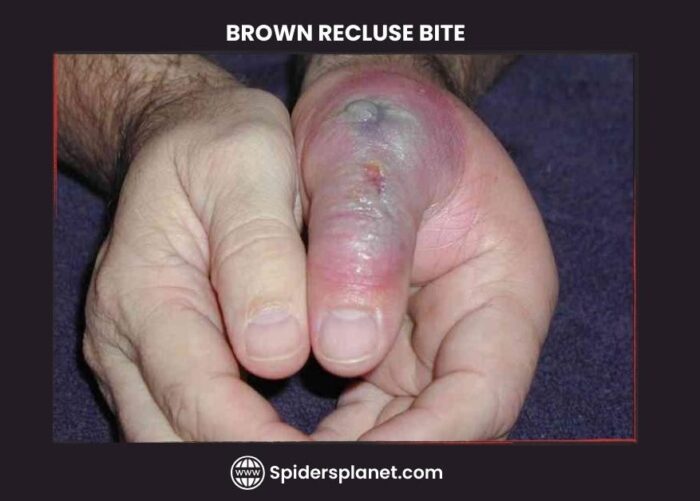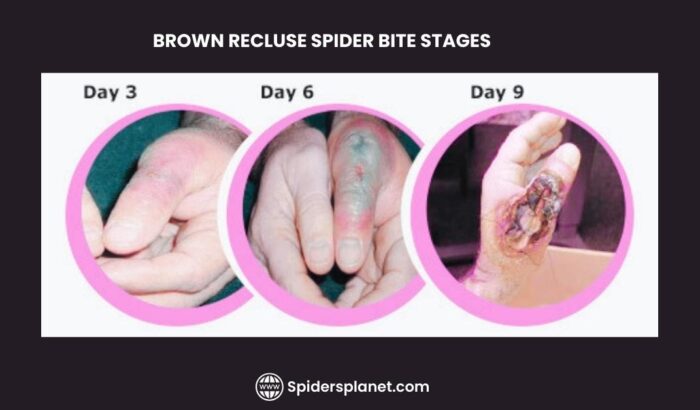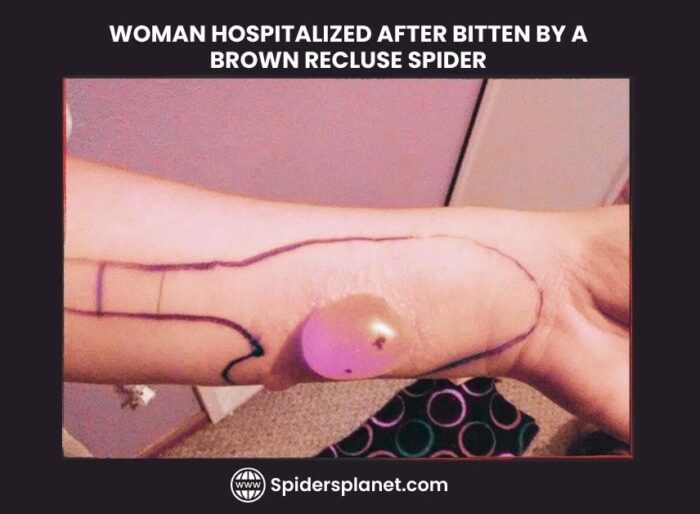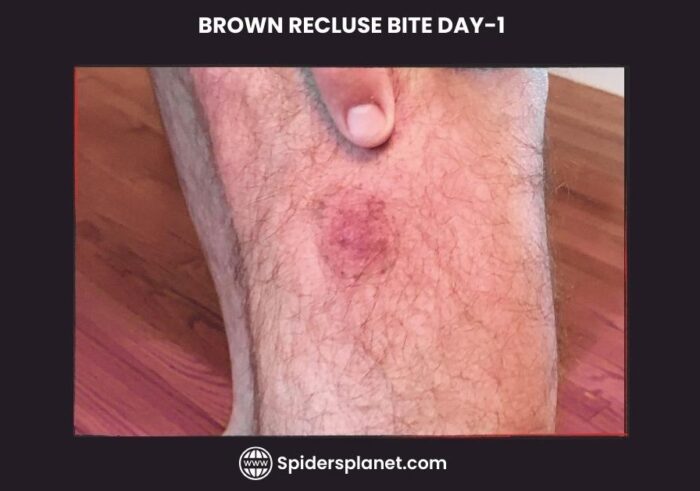In the world of arachnids, the brown recluse spider is an enigmatic figure and a bit scary. Its notable characteristics, including potent venom and distinctive markings (violin like), set it apart, rendering it distinct from fellow spiders.
While these spiders are generally reclusive, their bites have earned a notorious reputation for causing mysterious and potentially harmful effects on their victims.
The spider’s venomous bite holds potential risks, a deep understanding of its biology, habits, and bite symptoms becomes crucial to avoid encounters and get quick medical help if needed.
Continue reading to find out more about the Loxosceles Reclusa bite, its symptoms, and explore the best treatment options in the upcoming information.
How to Identify a Brown Recluse Spider?
The brown recluse, scientifically named Loxosceles reclusa, is a venomous spider mainly found in the central and midwestern United States. Female brown recluse spiders are about 1⁄4 to 1⁄2 inch in size, with a leg span of up to 1 inch. Males are roughly half the size. They come in colors like light to medium brown, whitish, tan, or blackish gray.
Identification traits of the brown recluse spider include:
- Violin-shaped mark on its cephalothorax
- Six eyes in three pairs
- Distinct light brown legs without spines
- 6 to 20 millimeters in length with a leg span of around 25 millimeters
Loxosceles Reclusa Bite:
According to research among the 20,000 spider species in America, only 60 can bite humans, and out of these, only four are considered potentially dangerous: the brown recluse, black widow, hobo, and yellow sac spider.
However, only the brown recluse and black widow have been associated with serious diseases and very rare instances of death.
The brown recluse carries a venom with sphingomyelinase D, causing tissue destruction. Most bites are minor, but some lead to loxoscelism, involving skin necrosis, a condition known as necrotic arachnidism, and systemic symptoms.
The spider is rarely aggressive, typically biting when pressed against the skin.
The Brown Recluse Spider Venom:
The venom produced by the brown recluse spider consists of a complex mix of enzymes. These enzymes can induce hemolysis, a process in which the walls of red blood cells rupture.
When this happens, the contents of the cells, including the red, oxygen-carrying protein called hemoglobin, are released into the surrounding area. In simple terms, the venom can cause the breaking open of red blood cells, leading to the release of their contents, which can have various effects on the body.
Bite from Loxosceles Reclusa Symptoms:
Being bitten by a brown recluse spider can lead to different reactions:
- From slight skin irritation to lesions, depending on where the bite occurs and the amount of venom injected
- Redness, swelling, and blisters may not be noticed until later.
- In some cases, people may experience additional symptoms such as fever, convulsions, itching, nausea, and muscle pain.
- Fatigue
- A “bulls-eye” pattern around the bite
- A white blister that may eventually turn black
- In severe cases of a Loxosceles Reclusa bite, blood supply to the bite area can be disrupted, leading to the formation of black tissue scarring known as an eschar.

How Serious Is a Brown Recluse Spider Bite?
While most brown recluse spider bites cause localized damage to the soft tissues at the site, it’s a matter that shouldn’t be underestimated.
Though uncommon, there have been unfortunate instances, especially among children, where these bites have led to fatal outcomes. This emphasizes the significant role of prevention in managing potential risks.
How is a Brown Recluse Spider Bite Identified?
A Loxosceles Reclusa bite is identified by two small puncture holes, initially displaying a pale center surrounded by a red and inflamed outer ring.
Within the first hours, the affected area becomes red, itchy, and painful, progressing over days to form an ulcer that transforms into a deep wound. The healing process results in a thick, black scab.
Untreated bites may lead to necrotic lesions, causing significant tissue damage and lasting scars. Diagnosing such bites is challenging, particularly without witnessing the incident, and symptoms may take hours to appear.
A case study exemplifies the struggle of doctors treating a patient with a red, swollen bug bite evolving into a blister and black eschar, accompanied by systemic symptoms like fever, diaphoresis, nausea, and diarrhea.
Brown Recluse Spider Bite Stages:
The progression of Loxosceles Reclusa bite can be understood by following distinct stages, each with its characteristics:

- Day 1: The initial bite is often painless and unnoticed due to the spider’s small fangs, making it challenging to identify until symptoms emerge.
- Day 2-3: After 24 hours, the bite site may exhibit redness, swelling, itching, burning sensation, and the formation of a small blister or bump.
- Day 3-7: A characteristic “bulls-eye” lesion develops, featuring a central red or purple area, a ring of white or pale skin, and an outer ring of red skin.
- Day 4-10: Day Severe cases may progress to skin necrosis within 1 to 2 weeks, presenting as a black or blue discoloration, an open sore or ulcer, slow healing, and potential scarring.
- Day 5-6: Rarely, systemic symptoms affecting the entire body may occur, including fever, chills, nausea, vomiting, muscle aches, weakness, rash or hives, joint pain, and, in extreme cases, hemolytic anemia.
- 3-4 Weeks: In most cases, the healing process for a Loxosceles Reclusa bite takes about three to four weeks. During this period, a thick, black scab usually forms, providing coverage to the wound as it undergoes the recovery process.
Spider Bite Treatment Brown Recluse:
What You Will Do for Brown Spider Bite?
If you suspect a Loxosceles reclusa bite, seek immediate medical attention. Treatment often involves pain relievers, antibiotics, and antihistamines.
In severe cases, surgery may be necessary to remove dead skin tissue. Swift medical intervention is crucial for managing potential complications and promoting effective recovery.
Related Post: The Top 8 Giant Arachnids Of Texas With Images!
How to treat a Brown Recluse Spider Bite at Home?
A recluse spider bite can be cured at home initially if you adhere to these guidelines until professional medical assistance is available:
- Thoroughly cleanse the affected area using soap and water.
- Apply ice wrapped in a clean cloth to the bite area, leaving it on for 10 minutes, followed by a 10-minute interval without ice. Repeat this cycle. Adjust the duration if there are concerns about blood flow problems to avoid potential skin damage.
- Keep the impacted area immobile, if feasible, to impede the spread of venom. Consider employing a makeshift splint for bites on the arms, legs, hands, or feet.
- Loosen clothing and remove any tight jewelry, including rings.
When to go to the hospital for a spider bite?
If you encounter any of the following symptoms after a Loxosceles reclusa bite, such as severe pain, redness, and swelling at the bite site, nausea, vomiting, abdominal cramps, fever, chills, muscle aches, difficulty breathing, itching, rash or hives, or a spreading red streak from the bite site is imperative to prioritize your well-being.

If you are unsure whether to seek medical help after a Loxosceles Reclusa bite, it is best to be cautious and go to the hospital. Getting prompt medical assistance is crucial for preventing serious complications.
Untreated Loxosceles Reclusa Bite:
If the bite area keeps getting bigger and the pain gets worse, the wound might be infected, especially if it starts oozing a cloudy liquid. Infections can be risky and spread beyond the wound, so it’s important to seek help promptly.
What Preventive Measures can you take?
Brown recluse spiders typically avoid conflict and resort to biting only when they perceive a threat. Despite their non-aggressive nature, their bites can be painful and, in rare cases, pose potential risks to health.
Employing preventive measures is crucial to minimize the risk of encountering these spiders. Consider the following tips:
- When outdoors, especially in regions where brown recluse spiders are common, dress in long pants and sleeves to protect your skin from potential bites.
- Use insect repellents containing DEET, known for its effectiveness in repelling brown recluse spiders.
- Before putting on clothes or shoes, shake them out to ensure there are no hidden spiders.
- Brown recluse spiders are attracted to clutter, so keep your living space clean and clutter-free to discourage their presence.
- Prevent spider entry by sealing cracks and crevices in your home.
- Be mindful when relocating boxes and other items, as spiders may be concealed within them.
- Reduce the likelihood of spiders infiltrating by storing shoes and clothes in sealed containers.
- Periodically check for signs of brown recluse spiders, including irregular and messy webs, to address potential issues promptly.

- If you come across a brown recluse spider, avoid attempting to kill it. Instead, gently guide it away or capture it in a glass jar for release outdoors.
- Suspecting a Loxosceles Reclusa bite warrants immediate medical attention. Early intervention is essential in preventing serious complications.
Related Articles:
FAQs:
Can a brown recluse spider bite cause staph infection?
Certainly, a bite from a Loxosceles Reclusa has the potential to introduce bacteria into the skin, possibly resulting in a staph infection. It is important to note that this complication is uncommon.
Do brown recluse spider bites itch?
Indeed, itching is a common occurrence with brown recluse spider bites, particularly during the initial stages.
How often do brown recluse spiders bite?
Brown recluse spiders are generally non-aggressive and infrequently bite humans. They are more likely to bite when they perceive a threat or when they feel trapped.
Can brown recluse spider bites cause joint pain?
Yes, the bite by a brown recluse can cause joint pain in your body.
Can a brown recluse spider bite kill you?
Although brown recluse spider bites can be extremely painful and lead to tissue damage, fatalities are rare. In the United States, there have been only about six documented deaths attributed to brown recluse spider bites.
How long do brown recluse spider bites last?
Brown recluse spider bites can take several weeks to heal completely. In some cases, the bite may leave a scar.
Are brown recluse spiders poisonous?
Indeed, brown recluse spiders are venomous. The nature of their venom is cytotoxic, indicating that it has the potential to damage cells.
Some Bonus Answers to FAQs:
How common is it for brown recluse spiders to bite dogs?
It is uncommon for a brown recluse spider to bite a dog unless the dog is very small or actively provoking the spider. In the event of a Loxosceles Reclusa bite on a dog, the symptoms tend to be similar to those observed in humans.
Do Brown recluse spider bites cause a rash?
A brown recluse spider bite may cause a rash around the bite site. The rash may be red, itchy, and painful.
Best antibiotic for a brown recluse spider bite?
There is no specific antibiotic that is best for treating brown recluse spider bites. However, your doctor may prescribe an antibiotic to prevent infection if the bite is severe.
Do baby brown recluse spider bites?
The venom of baby brown recluse spiders is equivalent to that of their adult counterparts. Consequently, a bite from a baby brown recluse spider carries a comparable level of seriousness to that of an adult Loxosceles Reclusa bite.
Do brown recluse spiders bite on cats?
Brown recluse spider bites are relatively uncommon in cats, as most spiders have fangs that are too small to penetrate feline skin.
However, bites can occur, and it is important to be aware of the signs and symptoms so you can seek veterinary care promptly.
Is there any brown recluse spider antivenom?
In the United States, there is currently no antivenom commercially accessible for brown recluse spider bites. The complexity of the spider’s venom, which comprises a range of challenging-to-neutralize toxins, contributes to the absence of an available antidote.
Furthermore, there is insufficient evidence supporting the effectiveness of antivenom in the treatment of brown recluse spider bites.
Final Thoughts:
In the world of spiders, the brown recluse is intriguing yet potentially risky. Its venomous bite, marked by stages like redness and blistering, demands attention. Despite being uncommon, serious outcomes emphasize the need for prevention and swift medical help.
Identifying a brown recluse involves recognizing its distinctive features, like a violin-shaped mark. Home care for bites includes cleansing and applying ice, but immediate medical attention is crucial.
Treatment may involve pain relievers, antibiotics, or surgery for severe cases. Prevention tips include wearing protective clothing outdoors and keeping living spaces clutter-free.
Understanding these aspects aids in managing potential risks and promoting effective recovery. I hope this guide will help you to understand the spider bites and how you can treat them.




Leave a Reply